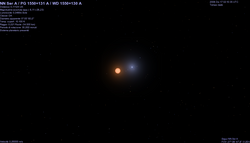| Observation data Epoch J2000 Equinox J2000 | |
|---|---|
| Constellation | Serpens |
| Right ascension | 15h 52m 56.12035s [1] |
| Declination | +12° 54′ 44.4293″ [1] |
| Apparent magnitude (V) | +16.51 [2] |
| Characteristics | |
| Spectral type | WD DAO1 / M4V [3] |
| Astrometry | |
| Proper motion (μ) | RA: −30.170±0.055 mas/yr [1] Dec.: −59.084±0.057 mas/yr [1] |
| Parallax (π) | 1.9438±0.0662 mas [1] |
| Distance | 1,680 ± 60 ly (510 ± 20 pc) |
| Orbit [3] | |
| Period (P) | 0.13008017141(17) d |
| Semi-major axis (a) | 0.934 ± 0.009 R☉ |
| Eccentricity (e) | 0.0 |
| Inclination (i) | 89.6 ± 0.2° |
| Semi-amplitude (K1) (primary) | 62.3 ± 1.9 km/s |
| Semi-amplitude (K2) (secondary) | 301 ± 3 km/s |
| Details [3] | |
| White dwarf | |
| Mass | 0.535 ± 0.012 M☉ |
| Radius | 0.0211 ± 0.0002 R☉ |
| Surface gravity (log g) | 7.47 ± 0.01 cgs |
| Temperature | 57000 ± 3000 K |
| Red dwarf | |
| Mass | 0.111 ± 0.004 M☉ |
| Radius | 0.149 ± 0.002 R☉ |
| Other designations | |
| NN Ser, PG 1550+131, WD 1550+130 | |
| Database references | |
| SIMBAD | data |
NN Serpentis (abbreviated NN Ser) is an eclipsing post-common envelope binary system approximately 1670 light-years away. [3] The system comprises an eclipsing white dwarf and red dwarf. The two stars orbit each other every 0.13 days. [3]
Contents
In 1982, Richard F. Green et al. found the star in the Palomar Green Survey, and determined it to be a possible cataclysmic variable star. They gave it the name PG 1550+131. [4] Photometric observations by John W. Wilson et al. in 1983 showed that PG 1550+131 was indeed a variable star. [5] Reinhold Haefner discovered that the star is an eclipsing binary, in 1988. [6] It was given its variable star designation, NN Serpentis, in 1989. [7]

